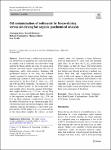Item Infomation
Full metadata record
| DC Field | Value | Language |
|---|---|---|
| dc.contributor.author | Jiang, Chunqing | - |
| dc.contributor.author | Robinson, Rachel | - |
| dc.contributor.author | Vandenberg, Richard | - |
| dc.date.accessioned | 2023-08-07T03:54:13Z | - |
| dc.date.available | 2023-08-07T03:54:13Z | - |
| dc.date.issued | 2023 | - |
| dc.identifier.uri | https://link.springer.com/article/10.1007/s10653-023-01594-9 | - |
| dc.identifier.uri | https://dlib.phenikaa-uni.edu.vn/handle/PNK/8707 | - |
| dc.description | CC-BY | vi |
| dc.description.abstract | Freeze-drying is widely used in geochemical laboratories for preparing wet solid environmental samples such as sediments and soils before being analyzed for their contents and states of various metal elements and labile organic components that may be temperature- and/or redox-sensitive. Screening bulk geochemical analysis of two Artic lake sediment samples prepared by freeze-drying displayed unexpectedly high contents of labile organic matter (OM) represented by the Rock–Eval S1 peaks (e.g., 8.12 and 4.84 mg HC/g sediment). The amount of labile OM was reduced greatly for the freeze-dried sediment samples after a thorough cleaning of the freeze-drier sample chamber (e.g., 2.75 and 1.46 mg HC/g sediment), but was still significantly higher than that of the equivalent air-dried samples (e.g., 0.76 and 0.23 mg HC/g sediment). | vi |
| dc.language.iso | en | vi |
| dc.publisher | Springer | vi |
| dc.subject | Oil contamination | vi |
| dc.subject | organic geochemical analysis | vi |
| dc.title | Oil contamination of sediments by freeze-drying versus air-drying for organic geochemical analysis | vi |
| dc.type | Book | vi |
| Appears in Collections | ||
| OER - Khoa học môi trường | ||
Files in This Item:

